This fishing report charts my fishing trips to the Welsh Dee to keep the readers abreast of how the river has been fishing. Hopefully, it will be helpful to anyone who is planning a fishing trip to the Welsh Dee.
The extremely wet start to 2024 across North Wales and much of the UK has continued into April. Resulting in a flooded and unfishable Welsh Dee for most of the time. However, during the occasional dry spells, I managed to squeeze in a few fishing trips and caught some beautiful trout and grayling, despite the high river levels.
So, let’s look at how the Welsh Dee has been fishing…
April Trout Fishing Report
Fishing at Llangollen – 16th April
Wet and windy weather had kept the Welsh Dee flooded since my last fishing trip at the beginning of April. However, following a few days of dry weather the river fell to 0.94m at Manley and I took this opportunity to fish at Llangollen with Graham, who had the day off work.
The weather seemed OK but when we arrived at Llangollen the wind was gusting more than we’d expected. Graham caught several grayling fishing sheltered spots below the town on a hare’s ear nymph but we didn’t encounter any trout.
After lunch, we moved upriver to fish Duncan’s Pool from the left bank. The river there was much higher than I’d expected and fishing was challenging with the sun beaming onto the river.
Fishing the margins didn’t produce anything. So, I switched to fishing the deep, faster water with a team of heavy nymphs (point: #12 large tungsten jig nymph; middle: #14 peacock quill nymph with a 3mm TB; top: #16 hare’s ear nymph with a 2mm copper TB).
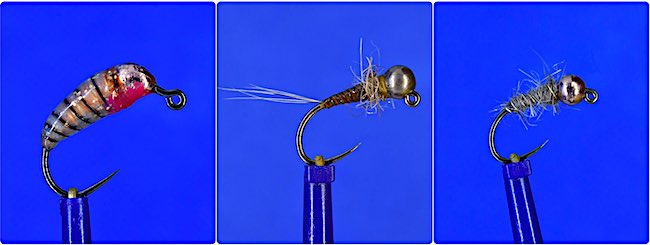
After a few cast into the deep run, I had a solid take and a wild brown trout came flying out of the water. The hook held and I netted a beautiful brown trout that had taken the quill nymph.
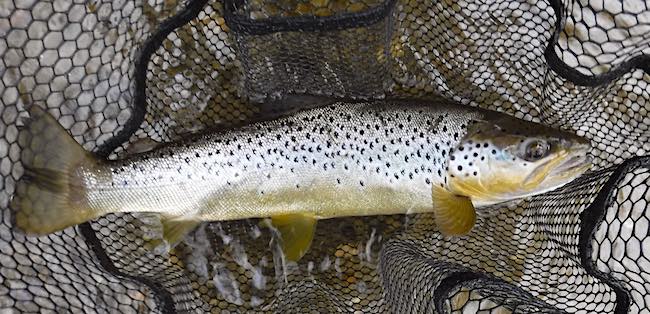
Graham added some additional weight to his set-up so that his nymphs bounced along the riverbed in the deep channel. The change did the trick and he hooked a lovely brown trout that gave him a short aerobatic display before throwing the hook.
Fishing the remainder of the pool with the heavier nymphs produced a couple of small trout. The weather had started to deteriorate so we called it a day and headed off home.
Fishing above Corwen 3rd April
Fishing the Welsh Dee had been on hold for a few weeks because the river had been in flood since the middle of March. So, when a brief dry spell allowed the level to drop off at Bala to 0.41m I squeezed in a trip.
It must have rained on the hills overnight because when I arrived the river was carrying quite a bit of colour. So, set my Vision Nymphmaniac rod to fish a team of nymphs spaced 18″ apart on a 4lbs fluorocarbon leader (point #12 pheasant tail nymph with a 4 mm gold TB, middle dropper #14 pink squirmy with a 3.5 mm pink TB: top dropper #16 hares ear with a 2.5 gold TB).
I worked my way to the top of the beat fishing all the slack water spots but I didn’t get any takes.
During my break for lunch, the coloured water started to clear and this enthused me to fish my way back to the car. After fishing a couple of pools, I had my first take of the day which turned out to be a juvenile grayling. A few casts later I caught a lovely grayling that had fallen for the squirmy worm.
Things were looking up and now I just needed to find some trout.
So, I switched the squirmy worm on the middle dropper for a #12 black pheasant tail nymph with a red collar and silver 3.5 mm tungsten bead.
Then headed down to a bend in the river where the water flowed over exposed bedrock into a pool containing two slack water lies behind large boulders.
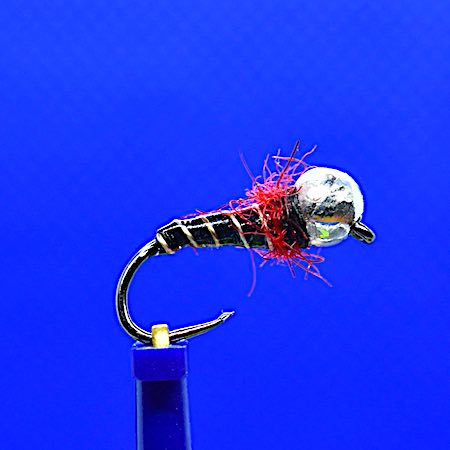
I had a good feeling that one of these lies would hold a brown trout. The first lie produced a small brown trout that fell for the PTN on the point.
After a few casts into fishing the next lie, I had a savage take and my rod bent around into a
big trout that shot off downriver.
After a dicey few minutes, I got it under control and a beautiful brown trout slid into my net which had fallen for the black pheasant tail nymph.
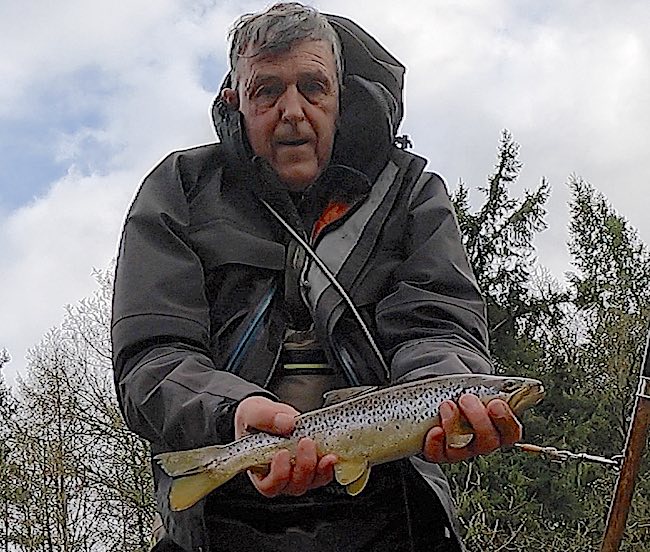
I didn’t have any more takes fishing the remainder of the pool and with the weather starting to deteriorate I decided to head home.
March Trout and Grayling fishing report
Fly fishing at Llandderfel – 11th March
I caught several grayling mainly on a size 16 hare ear with copper bead 1.5mm while fishing with Ian. Mainly caught in the pool opposite the dyke.
At Llandderfel, it had been windy overnight and with a wet front moving I just had time to squeeze my last grayling fishing trip of the season in.
It was a blustery day and with no sign of surface activity I decided to fish the pool opposite the dyke with nymphs. I set up my 11ft 3# Vision Nymphmaniac to fish three nymphs space 18″ apart on a 4 lb fluorocarbon leader (point: #12 PTN with a 4 mm black TB; middle dropper: #14, peacock quill nymph with a 3 mm silver TB; top dropper: #16, Hares Ears 2 mm gold TB).
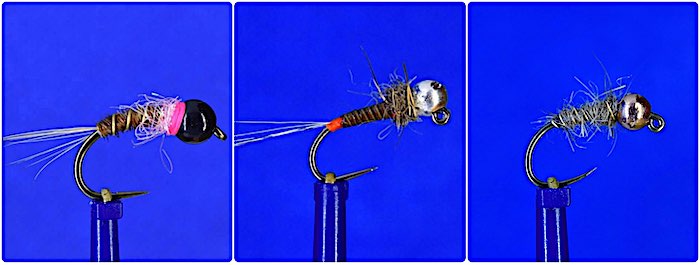
Starting by the Alder bush halfway down the pool, I slowly fished across and up the pool in a zig-zag pattern. The fishing was slow but as I approached the faster water opposite the dyke my line stopped and I caught my first grayling of the day pheasant tail nymph.
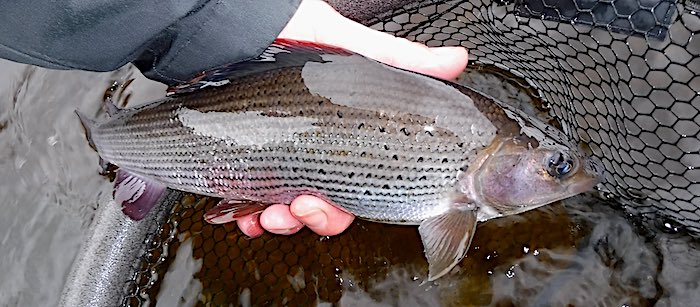
Fishing on produced two more similar-sized grayling, and then under the tree close to the fae bank my the leader darted sideways, and
BOOM! – my reel screamed as a grayling took off downriver.
Carefully, I gained control and netted a beautiful grayling that had taken the hare’s ear nymph on the top dropper.
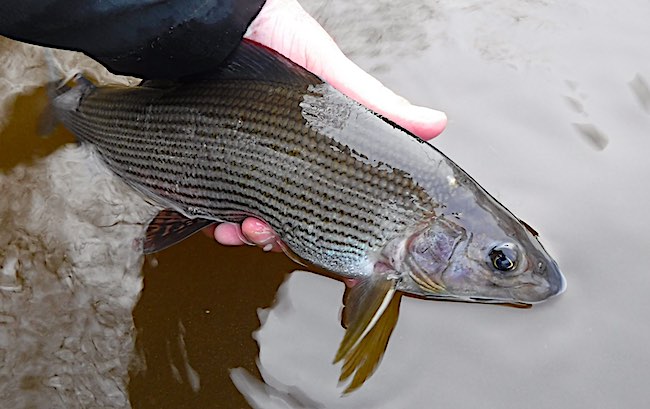
After a break for lunch, I moved downriver and crossed over to the left bank to fish the next fast run. This produced two more nice grayling and a few smaller fish most of which took the peacock quill nymph on the middle dropper.
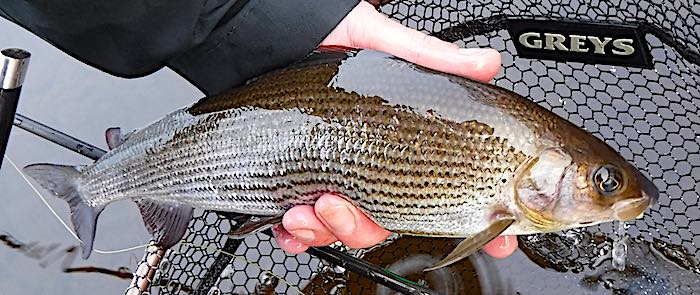
The temperature dropped at about 3 O’Clock and the fishing went dead As if…
someone had turned the switch off.
So, after an enjoyable day, I headed off home.
Fly fishing at Bangor On Dee – 6th March
After a few more days of dry weather, the river level dropped to 0.8m @ Manley Hall gauge and I decided to try my luck trout fishing at Grove Farm near Bangor-On-Dee. It’s a beautiful beat of the Welsh Dee that has produced some lovely early-season brown trout.
It was a cold start to the day (5oC) and I hadn’t seen rising fish or emerging fly life on my walk up to the head of the first pool. So, I decided a three-fly Euro-nymph set-up would be the best chance of tempting a brown trout (point: #12 orange collar pheasant tail nymph with a 3.5mm orange TB; middle dropper: #14 purple collar black pheasant tail nymph with a 3mm silver TB; top dropper: #16, Hare’s Ear nymph with a 1.5mm copper TB).
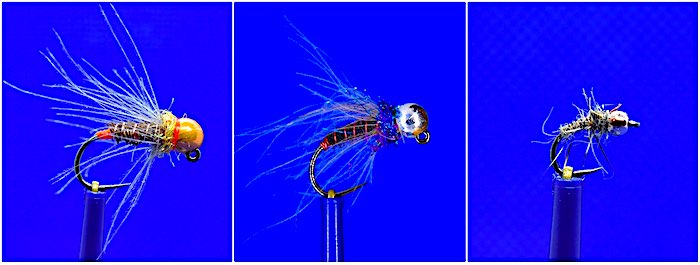
Starting in the slack water below the willow bushes, I methodically fished downriver for 15 minutes without any luck.
Therefore, I swapped the nymph on the middle dropper for a #14 pink squirmy worm. Shortly after the fly change, I had a firm take and the rod bent around as it took off into the main flow. Eventually, I gained control and a beautiful grayling that had taken the pink squirmy was netted.
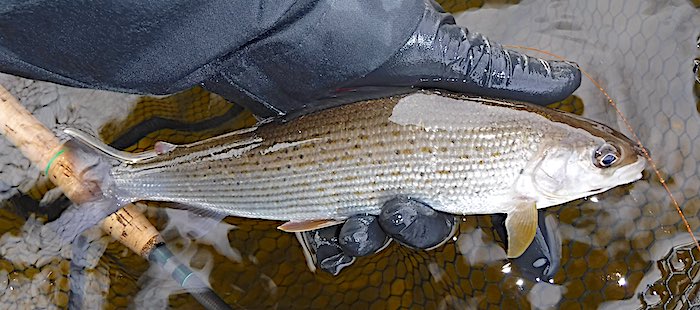
Fishing the remainder of the pool produced a few small grayling and trout parr.
Fly fishing the Cemetry Pool
After a break for lunch, I walked upriver to fish the Cemetry Pool which usually holds a few nice brown trout. The temperature had risen a couple of degrees but I still hadn’t seen anything happening at the surface. So, I continued fishing the team of nymphs that had been successful.
Starting halfway up the pool I fished upriver into the riffle at the head of the pool. I didn’t have any takes until I reached the drop-off zone. Where I had a solid take and the rod bent round into a nice fish that took off into the main current. After a short struggle, a lovely trout was guided into the net that had fallen for the pheasant tail nymph on the point.
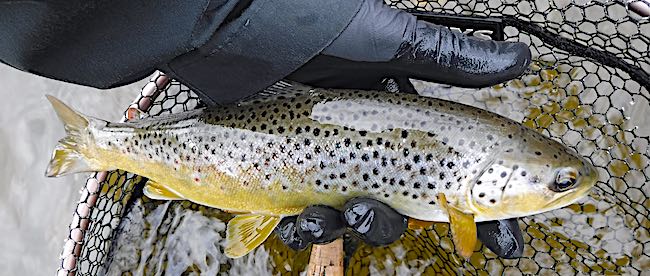
Fishing up into the shallow riffle produced another trout and grayling on the squirmy worm. At about 3 pm the temperature dropped and I didn’t catch anything else.
Fly fishing at Llangollen – 5th March
The river was running off after the heavy rain at the end of February but the level had dropped to 0.91m (Manley Hall gauge), which was OK for fishing Duncan’s Pool.
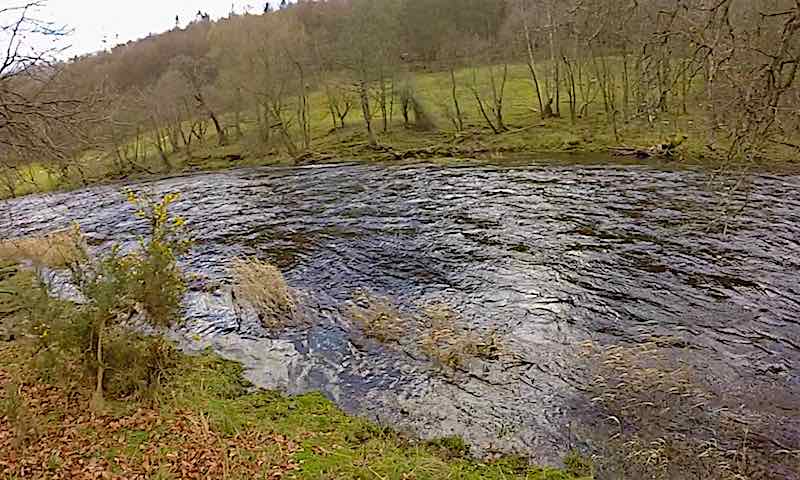
It was a cold start to the day (3oC) and with no sign of surface fly life. So, I decided a three-fly Euro-nymph set-up would be the best chance of tempting a brown trout (point: #12 orange collar pheasant tail nymph with a 3.5mm orange TB; middle dropper: #14 purple collar black pheasant tail nymph with a 3mm silver TB; top dropper: #16, Hare’s Ear nymph with a 1.5mm copper TB).

Starting in the slack water opposite the rock outcrop on the far bank, I methodically fished my way downriver. After missing a couple of takes, I caught a few small graylings.
When I reached the drop-off zone, I had a savage take, a brown trout went airborne, and darted off downriver. Carefully, I got things under control and netted my first Welsh Dee brown trout of the new season that had fallen for the black pheasant tail nymph on the middle dropper.
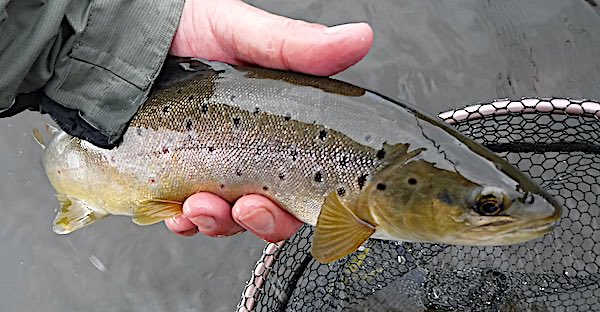
Fishing the remainder of the pool with the nymphs produced a smaller brown trout and a grayling.
While having a break for lunch a few large dark olives began hatching and then a trout close to the far bank began picking them off.
Quickly, I set a 9ft 5# rod to fish a Jingler dry fly on a 12ft 6X tapered leader.
I took up a position below the rising trout and placed the Jingler 3ft above where it was rising. The trout ignored the fly as it drifted by but on the second drift, there was a swirl…
the fly disappeared and it was game on.
After an initial jump, the trout divided deep into the main channel stripping line from the reel. Everything held and I guided another beautiful Welsh Dee brown trout to the net.
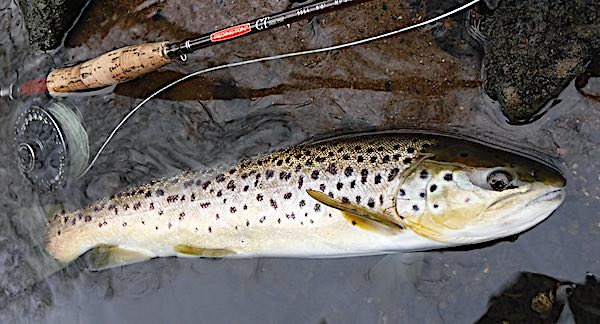
The hatch of large dark olives didn’t last long and the river went dead. So, please with my catch for the day, I headed off home to warm up.
February Grayling Fishing Report
A fishing trip to fish Ty Mawr Country Park – 17th February
The weather forecast for the remainder of February wasn’t great for North Wales but a brief spell of dry weather helped the river level subside to a barely fishable level (1.1m Manley Hall gauge). Making it possible to squeeze in a last-minute fishing trip with Graham.
It’s been ages since I last fished the Welsh Dee where it passes through Ty Mawr Country Park at Newbridge. This beat is better fished when the river is closer to its summer level but there are a couple of places that can be fished in high water, which I wanted to show my mate Graham.
After showing him where to park, we followed the path alongside the viaduct down to the river.
The main part of the Cheery Tree Pool, immediately above the Viaduct, was unfishable because the water was racing through the pool.
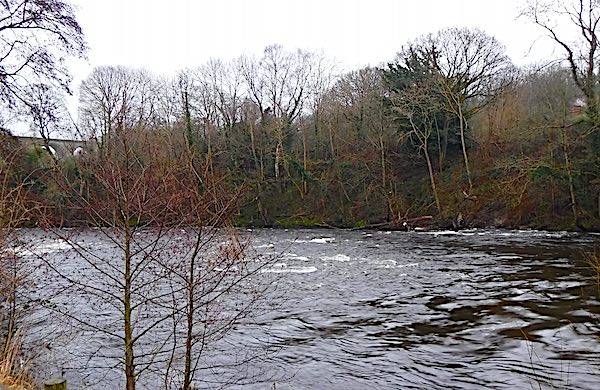
We continued upriver to the next pool, Dyke Run, where the river turns 90o as it hits the large stone bluff on the far bank.
Grayling are often found lying in the slacker water below the large back eddy. So, that’s where we started fishing.
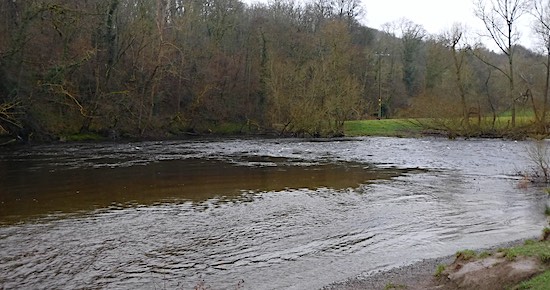
It was a mild (13oC) day but we hadn’t seen any flies hatching, so I opted to start by Euro nymphing using a team of three nymphs (point: #12 olive tungsten jig back; middle: #14 blood red squirmy; top: #16 hares ear nymph with 2.5mm copper TB).
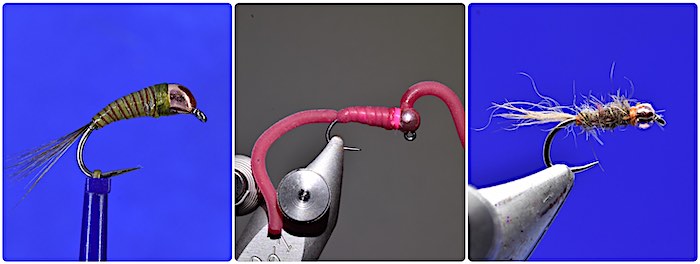
I began by fishing the nymphs along the gravel bar formed by the back eddy and it wasn’t long before I caught a grayling on the squirmy worm, which was followed by a small wild brown trout.
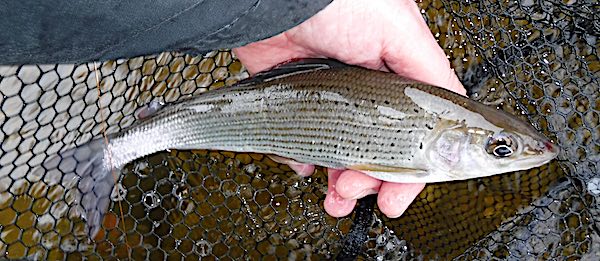
Graham had chosen to fish the tail of the pool with a team of wet flies that produced one grayling on a March Brown spider.
After he’d finished, I fished the slacker sections of the tail with the nymphs and caught two lovely grayling that were lying close to the bushes on the near-bank. One grayling fell for the hare’s ear nymph and the other on the squirmy.
For the final hour, I took Graham upriver to show him the other places that are worth fishing when the river is closer to its summer level. We fished the margins of the Long Meadow Pool but without any success because the river was too high.
Welsh Dee Grayling Fishing Report – 13th February
A break in several days of wet weather allowed the river level to drop just enough (0.97m @ Manley Hall gauge) to squeeze in a mid-week grayling fishing trip at Llangollen.
I selected to fish at Duncans Pool because my previous fishing trip there at the beginning of February produced some beautiful grayling.
It was a mild day (12oC) but I didn’t see any flies hatching on my journey upriver. Therefore, I set up my 11ft #3 Vison Nymphmaniac rod to fish a team of nymphs (point: #12 Olive Tungsten Jig Back nymph; middle: #14 pink squirmy worm; top: #16 Hare’s Ear nymph with a 2mm copper TB).
The river level was higher than I’d expected and I could only nymph through the top section of the pool. Fishing upriver to the overhanging Chestnut tree produced three brown trout, a small sea trout and two small grayling on the pink squirmy worm.
In search of grayling, I went upriver to fish the Pipe Pool but the river was too high to fish the pool properly with the nymphing set-up. Therefore, I changed to fishing a team of wet flies on a floating line with a 7ft fast sinking tip (Point: #12 Black Pennell with a 2.5mm TB behind the hackle; middle: #12 Pheasant & Silver Grouse Spide; top: #14 Pearl-ribbed March Brown Spider).

To slow the swing of the wet flies it was necessary to fish them at a shallow downstream angle and add regular upstream mends. With that approach, I caught a nice grayling and brown trout that both fell for the weighted Black Pennell as it swung into the margin.
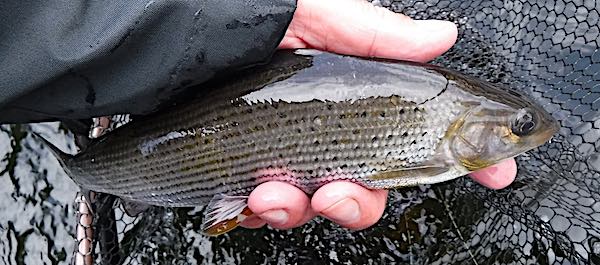
On my way back to the car, I caught another grayling and brown trout fishing the tail of Duncans Pool with the wet flies. Again, both fish were tempted by the Black Pennell.
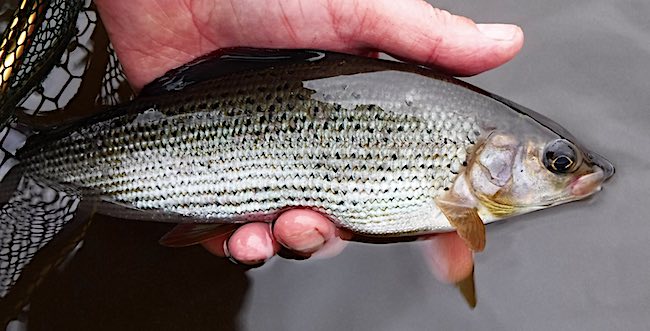
Grayling Fishing Report – Llangollen 3rd February
After my last fishing trip in January, heavy rain flooded the Welsh Dee catchment and it took a week of relatively dry weather for the river to fall to a fishable height (0.96m @ Manley Hall). So, with more rain in the forecast, I ventured out for a spot of grayling fishing at Duncans Pool on the Welsh Dee near Llangollen.
It was an overcast day when I pulled into the car park by Llantysilio Church but the sun was forecast to break through the cloud in the afternoon.
On my journey upriver to Duncans Pool I didn’t see any flies hatching, so I set my 11ft 3# Nymphmanaic rod to fish a team of nymphs on a Euro nymphing leader setup (point: #12 PTN with a 4mm gold TB; middle: #14 quill nymph with a 3 mm silver TB; top: #18 copper beaded HE).
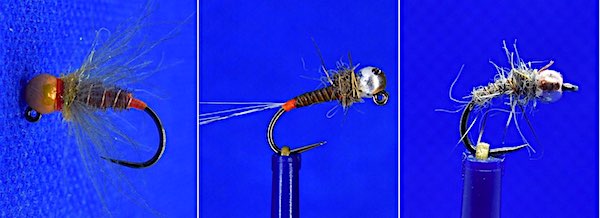
Starting about halfway up the pool I fished the nymphs methodically upriver to the shallow fast water near the overhanging Chestnut tree. Surprisingly, the nymphs didn’t produce any takes.
I switched the quill nymph on the middle dropper for a pink squirmy worm and fished the pool again. This change produced several lovely grayling that were tempted by the pink squirmy.

The high river level restricted fishing in the lower part of the pool from the bank. Fishing from the overgrown bank was difficult but I managed to catch a few more grayling on the squirmy and Hare’s Ear nymph.
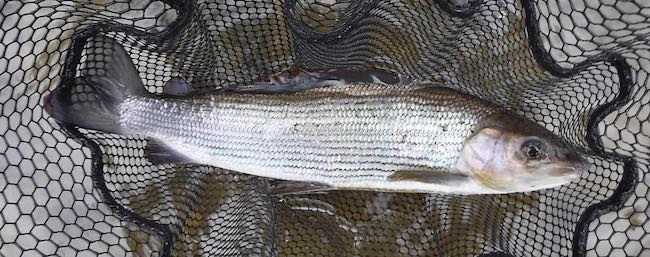
After a brief appearance, the sun disappeared at about 3 pm and so did the takes. Pleased with the results of my efforts I called it a day and went home before the next band of rain rolled in.
January Grayling Fishing Report
Grayling fishing on Llangollen Upper Beat – 20th January
After a very wet start to the New Year, the river level finally dropped enough to fish the Top Pool, which often holds a good head of grayling in winter. Weather conditions weren’t great because a storm was rolling in and the wind had picked up to gusts of 20-25mph. However, we still made the trip because the forecasted heavy rain would make it unfishable for the next week or so.
During our walk to the Top Pool, we met another angler who’d been fishing the Fridge Pool with nymphs for a couple of hours without any luck in the blustery condition. Not a good sign.
We continued upriver hoping that we would be sheltered from the wind by the woodland on both sides of the river. Unfortunately, the wind was blowing downstream quite strongly at the top pool.
No flies were hatching, so felt the best approach was to fish a team of nymphs close to the riverbed. I set up my 11ft 3# Vision Nymphmaniac fly rod to fish a team of three flies (point: #12 Olive jig back nymph: middle: #14 Black PTN with a 3mm silver TB; top: #16 purple collar quill nymph with a 2.5mm silver TB).
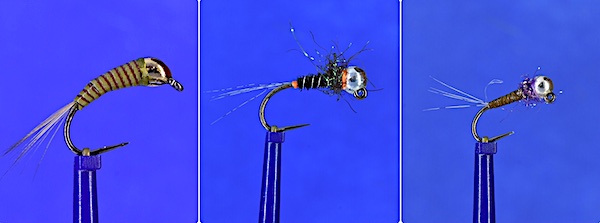
After a slow start, we eventually found the grayling below the fast water at the head of the pool opposite the large tree on the far bank. We caught several grayling, most of which fell for the black pheasant tail nymph on the middle dropper.

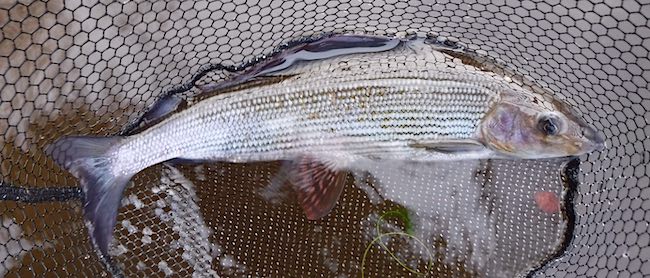
Final Notes:
If you’ve found this Welsh Dee fishing report useful, it would be great to hear about any fishing trips you have made to the Welsh Dee. Also, if you like I could add them to this post, which I plan to keep updated throughout the year.
Tight lines, Andrew
Well done Andrew a thoroughly in depth report. Some great tips and excellent fly patterns. Also some cracking brownies and grayling caught. Thank you for sharing. All the very best. Scott
Hi Scott,
Great to hear you enjoyed the post and thanks for the feedback.
Tight lines, Andrew